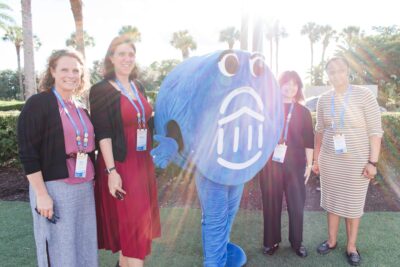What we learned from 12 system-wide technology implementations
A few weeks ago, EAB partnered with the California State University (CSU) System to host a system-wide student success summit. Hearing positive feedback and stories from the team not only re-energized me, but also got me thinking about how EAB could replicate their experiences to better support our other system members.
After seven years leading our member success efforts and watching a dozen systems across the country join the Student Success Collaborative and implement our technology platform, Navigate—I often reflect on a thought that briefly flickered across my mind as we prepared to welcome our first system member. I thought that implementation at a university system would be easier. (Centralized data! Common goals! Common practices!) But as anyone who has worked with or been part of a college or university system knows, it isn’t that simple.
Over the years working with CSU and others, I’ve learned some best practices for successful technology implementations across university or college systems. While particularly relevant for systems leaders, I hope these lessons will ring true for any student success leader.
Know (and use) your strengths
- Take advantage of existing shared goals: Appropriate goal setting is a big challenge for most standalone college and universities. But within a system, that work is often already done—there are already initiatives that all campuses are working toward. Systems can rely on common goals to prioritize different parts of a tech implementation, i.e. which units, which functionalities, and which outcomes come first. With a focused implementation plan, staff have a clear understanding of the long-term process and direct their attention efficiently and effectively.
- Activate your own experts: With so many staff and faculty members in each system, leaders can rely on their own local experts. The Virginia Community College System sent Brad Prillaman, a Student Success leader from the Danville Community College (DCC) campus, to visit two other schools in the system with a similar size and faculty advising structure. Brad shared his experiences engaging faculty and set expectations for the use of Navigate. He even met with faculty from both schools to share feedback from DCC faculty on how easy Navigate was to use, what they liked about it, and what processes Navigate helped them scale.
- Make the most of system conferences: Like CSU, many systems have annual conferences that bring together campus leaders in one forum. Systems can leverage these in-person gatherings to improve the alignment of organization-wide strategies for tech implementation.
In February, Arapahoe Community College (ACC) hosted a Colorado Community College System-wide collaboration conference, which nearly all system institutions attended, along with the Colorado Department of Higher Education and individuals from several four-year Colorado universities. Throughout the day, presenters and panelists shared how breaking down barriers between colleges can help break down barriers for students. Attendees reported the most valuable parts of the conference were making connections with colleagues from other schools, sharing practices for collaboration, and learning about other colleges and universities’ approach to the implementation of Navigate.
Know your weaknesses—and use these strategies to overcome them
- Establish a single source for measuring student success: Standardizing at scale is especially difficult with many campuses spread across an entire region or state. Without a shared technology and support structure, individual campuses can quickly deviate from shared metrics and reporting practices. This makes it hard to know if one school is falling off track. When all schools share a single source of truth in the form of a technology platform, there is much less opportunity to deviate from goals.
For example, one large system we work with uses Navigate to improve and track three key indicators for applicant enrollment and three indicators for term-over-term enrollment. Because of the system-wide use of Navigate, the different campuses speak the same language. This provides leadership with visibility into progress against goals, so campus stays on track toward the outcomes that matter most.
- Lean on strong leadership: With individual campus leaders serving vastly different student populations and responsible for various teams, it can be hard to keep everyone motivated and focused on a successful implementation. Strong, system-level leadership is a must. A system-level value leader can work with campus leadership to push forward implementation and ensure buy-in at the highest level by eliminating roadblocks, addressing naysayer concerns, and making decisions efficiently and conclusively.
- Strive for representation: Staff and leaders from different campuses have different priorities, needs, and concerns when it comes to tech implementation. You can’t please everyone, but you can make sure that representative voices are heard. Steering committees reflective of different colleges and different professional levels (including directors, VPs, etc.) can be a great resource to ensure your implementation team doesn’t turn into an echo chamber.
Multi-school systems have the opportunity—and responsibility—to serve a huge proportion of the students pursing a secondary degree in this country. That’s a tough position to be in: you must balance larger goals and initiatives with the capabilities and needs of each individual school without letting any fall too far behind. With strong leadership, clear channels of communication, and a shared technology platform, systems can empower their institution-level staff to support students in an efficient and effective way.
I’ve been pleased to see the impact of these efforts among the systems we work with. For example, ACC has seen a 225% increase in early alerts since partnering with EAB. CSU Long Beach has seen an 11 percentage point increase in their four-year graduation rate. We are learning that success at one campus can inform and drive success at others—helping systems deliver on their promise to students.
More Blogs

Four signs it’s time to break up with your student CRM

Three lessons from 1,200 student success leaders on higher ed’s future
